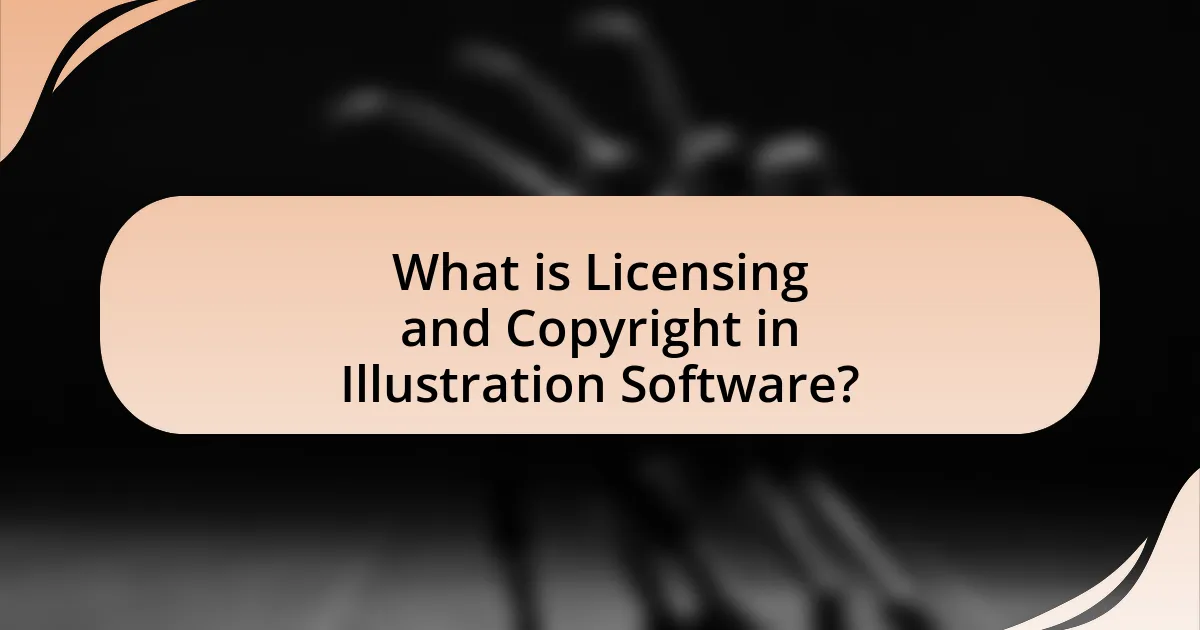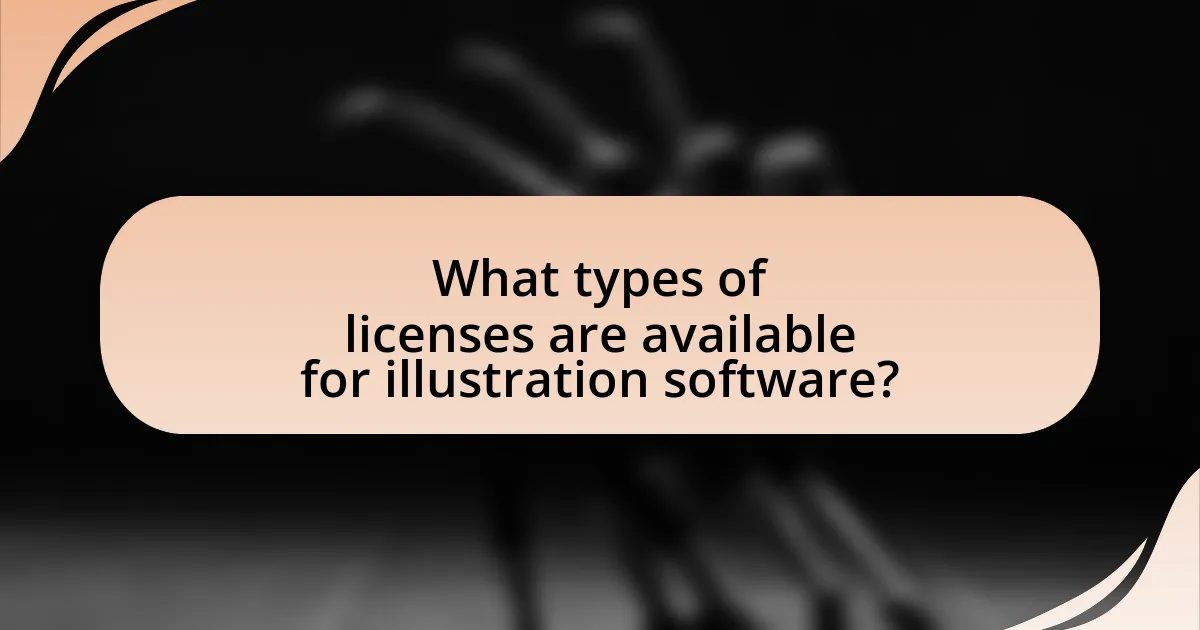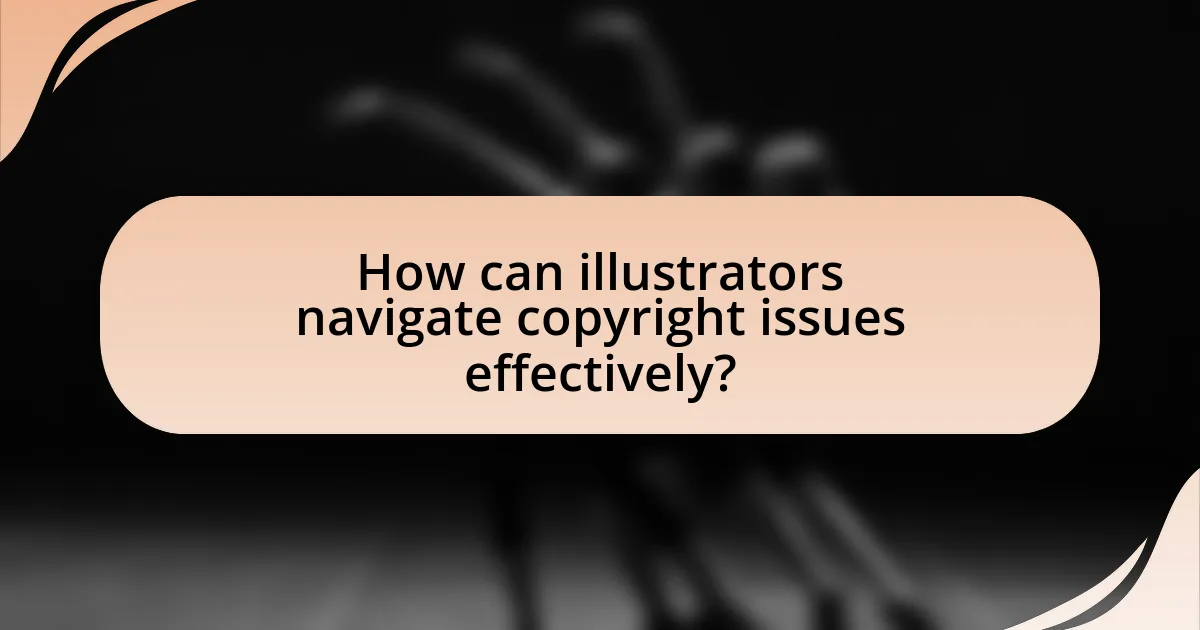The article focuses on the critical aspects of licensing and copyright in illustration software, detailing the legal permissions granted to users and the protections afforded to original works. It outlines the differences between licensing agreements and copyright law, emphasizing the importance of understanding these concepts for illustrators to safeguard their creative output and ensure proper compensation. Key components of licensing agreements, types of licenses available, and the implications of copyright infringement are discussed, alongside best practices for navigating these legal frameworks effectively. The article also highlights the risks illustrators face without adequate knowledge of licensing and copyright, underscoring the necessity of staying informed about legal developments in the field.

What is Licensing and Copyright in Illustration Software?
Licensing in illustration software refers to the legal permissions granted to users for the use of the software, while copyright protects the original works created using that software. Licensing agreements dictate how users can utilize the software, including restrictions on distribution, modification, and commercial use. Copyright law, on the other hand, automatically grants creators exclusive rights to their original illustrations, preventing unauthorized reproduction or distribution. For instance, under U.S. copyright law, an illustrator retains rights to their work unless they explicitly transfer those rights through a contract. This framework ensures that both the software developers and the illustrators are protected in their respective rights and uses.
How do licensing and copyright differ in the context of illustration software?
Licensing and copyright differ fundamentally in the context of illustration software, as licensing refers to the permissions granted by the software creator for the use of their product, while copyright is a legal protection that grants the creator exclusive rights to their original work. Licensing agreements dictate how users can utilize the software, including restrictions on distribution and modification, whereas copyright ensures that the creator retains ownership and control over the intellectual property, preventing unauthorized use or reproduction. For example, a user may purchase a license to use illustration software under specific terms, but the copyright remains with the software developer, who can enforce their rights against infringement.
What are the key components of licensing agreements?
The key components of licensing agreements include the scope of the license, payment terms, duration, territory, and termination conditions. The scope of the license defines what rights are granted, such as whether the licensee can reproduce, distribute, or modify the licensed material. Payment terms specify the fees or royalties to be paid by the licensee to the licensor, often including details on payment schedules. Duration outlines the time period for which the license is valid, while territory specifies the geographical area where the license applies. Termination conditions detail the circumstances under which the agreement can be ended by either party. These components are essential for clarifying the rights and responsibilities of both parties involved in the licensing agreement.
How does copyright protect illustrations created with software?
Copyright protects illustrations created with software by granting the creator exclusive rights to reproduce, distribute, and display their work. This legal framework applies automatically upon the creation of the illustration, as long as it meets the originality requirement, meaning it must be an independent creation that exhibits a minimal degree of creativity. The U.S. Copyright Office states that copyright protection covers both published and unpublished works, including digital illustrations, thereby preventing unauthorized use or reproduction by others. Additionally, copyright allows the creator to license their work, providing a means to control how it is used and to receive compensation for its use.
Why is understanding licensing and copyright important for illustrators?
Understanding licensing and copyright is crucial for illustrators because it protects their creative work and ensures they receive proper compensation for its use. Illustrators must navigate various licensing agreements to determine how their artwork can be used, whether for commercial purposes or personal projects. For instance, a study by the Copyright Office indicates that creators who understand their rights are more likely to enforce them, leading to better financial outcomes. Additionally, knowledge of copyright laws helps illustrators avoid legal disputes and infringement claims, which can be costly and damaging to their careers.
What risks do illustrators face without proper licensing knowledge?
Illustrators face significant legal and financial risks without proper licensing knowledge, including copyright infringement and potential lawsuits. Without understanding licensing agreements, illustrators may inadvertently use copyrighted materials without permission, leading to legal actions that can result in costly settlements or damages. For instance, a study by the Copyright Alliance indicates that copyright infringement cases can lead to penalties ranging from $750 to $30,000 per work, depending on the severity of the violation. Additionally, lack of licensing knowledge can hinder an illustrator’s ability to monetize their work effectively, as they may not be aware of the rights they retain or relinquish when licensing their illustrations.
How can copyright infringement impact an illustrator’s career?
Copyright infringement can severely hinder an illustrator’s career by leading to legal disputes, financial losses, and damage to professional reputation. When an illustrator’s work is used without permission, they may face costly legal battles to protect their rights, which can divert time and resources away from their creative projects. Additionally, financial losses can occur from lost licensing fees or potential earnings, as unauthorized use undermines the value of their original work. Furthermore, being associated with copyright infringement can tarnish an illustrator’s reputation, making it difficult to secure future clients or collaborations, as trust is a crucial component in the creative industry.

What types of licenses are available for illustration software?
There are several types of licenses available for illustration software, including perpetual licenses, subscription licenses, and trial licenses. Perpetual licenses allow users to own the software indefinitely after a one-time purchase, while subscription licenses require ongoing payments for continued access, typically on a monthly or annual basis. Trial licenses provide temporary access to the software, enabling users to evaluate its features before committing to a purchase. These licensing models cater to different user needs and preferences, ensuring flexibility in software acquisition.
What are the common types of licenses for illustration software?
Common types of licenses for illustration software include proprietary licenses, open-source licenses, and subscription licenses. Proprietary licenses grant users the right to use the software under specific conditions set by the developer, often requiring a one-time purchase or ongoing fees. Open-source licenses allow users to modify and distribute the software freely, promoting collaboration and community development. Subscription licenses provide access to the software for a recurring fee, often including updates and support. These licensing types are essential for understanding user rights and restrictions in the use of illustration software.
How do commercial licenses differ from personal licenses?
Commercial licenses allow users to utilize software or content for profit-generating activities, while personal licenses restrict usage to non-commercial, personal projects. Commercial licenses typically include broader rights, enabling users to create, distribute, and sell products derived from the licensed material, whereas personal licenses often prohibit any form of resale or commercial exploitation. For example, Adobe’s licensing terms specify that a commercial license permits the use of their software for business purposes, while a personal license limits usage to individual, non-commercial endeavors.
What is a subscription-based license, and how does it work?
A subscription-based license is a licensing model that allows users to access software or services for a specified period in exchange for regular payments, typically monthly or annually. This model enables users to utilize the latest features and updates without the need for a large upfront investment, as they pay a recurring fee instead. Subscription-based licenses often include customer support and maintenance, ensuring users have access to assistance and the most current version of the software. This approach is widely adopted in various industries, including illustration software, where it provides flexibility and affordability for users.
What factors should illustrators consider when choosing a license?
Illustrators should consider the scope of usage, exclusivity, duration, and territorial rights when choosing a license. The scope of usage defines how the artwork can be used, such as for commercial or personal projects, which directly impacts potential earnings. Exclusivity determines whether the license allows others to use the same artwork, affecting market competition. Duration specifies how long the license is valid, which can influence long-term projects or ongoing revenue. Territorial rights outline where the artwork can be used, which is crucial for international projects. These factors collectively influence the financial and legal implications of the licensing agreement, ensuring that illustrators protect their work while maximizing its value.
How does the intended use of illustrations affect licensing choices?
The intended use of illustrations significantly influences licensing choices by determining the scope and type of rights required. For instance, commercial use of illustrations necessitates a broader license that allows for reproduction, distribution, and potential modifications, while personal use may only require a limited license. Additionally, specific industries, such as advertising or publishing, often demand exclusive rights to avoid competition, further impacting the licensing agreements. According to the Copyright Act of 1976, the nature of use directly correlates with the rights granted, emphasizing the importance of aligning licensing choices with the intended application of the illustrations.
What are the implications of license restrictions on creative work?
License restrictions on creative work limit how creators can use, share, and monetize their creations. These restrictions can prevent artists from adapting or distributing their work freely, which may hinder collaboration and innovation within creative communities. For instance, a study by the World Intellectual Property Organization indicates that strict licensing can stifle creativity by imposing barriers to access and use, ultimately affecting the diversity of creative outputs. Additionally, license restrictions can lead to legal repercussions for creators who inadvertently violate terms, resulting in financial losses or damage to their reputation.

How can illustrators navigate copyright issues effectively?
Illustrators can navigate copyright issues effectively by understanding copyright laws, utilizing licensing agreements, and keeping detailed records of their work. Knowledge of copyright laws, such as the Berne Convention, which protects original works automatically upon creation, enables illustrators to assert their rights. Licensing agreements, like Creative Commons licenses, provide clear terms for how their work can be used by others, ensuring that illustrators retain control over their creations. Additionally, maintaining detailed records, including sketches, drafts, and correspondence, serves as proof of ownership and can be crucial in disputes. These strategies collectively empower illustrators to protect their intellectual property and avoid potential infringements.
What steps can illustrators take to protect their work under copyright law?
Illustrators can protect their work under copyright law by registering their artwork with the U.S. Copyright Office. This formal registration provides legal evidence of ownership and allows illustrators to pursue legal action against infringers. Additionally, illustrators should include copyright notices on their work, which serves as a deterrent against unauthorized use. Keeping detailed records of the creation process, including drafts and correspondence, can also support claims of originality. According to the U.S. Copyright Office, registration is not mandatory but is highly recommended as it enhances the ability to enforce rights and claim statutory damages in case of infringement.
How can registration enhance copyright protection for illustrations?
Registration enhances copyright protection for illustrations by providing legal evidence of ownership and establishing a public record of the work. When an illustrator registers their work with the U.S. Copyright Office, they gain the ability to sue for statutory damages and attorney’s fees in cases of infringement, which are not available for unregistered works. Additionally, registration serves as a deterrent against infringement, as it publicly asserts the illustrator’s rights and makes it more difficult for others to claim ownership. According to the U.S. Copyright Office, registered works are also eligible for a presumption of validity in court, further strengthening the illustrator’s position in legal disputes.
What are the benefits of using copyright notices on illustrations?
Using copyright notices on illustrations provides legal protection, deterring unauthorized use and infringement. Copyright notices serve as a clear indication of ownership, which can help in asserting rights in case of disputes. Additionally, they inform the public about the creator’s rights, potentially reducing the likelihood of unintentional misuse. According to the U.S. Copyright Office, including a copyright notice can also enhance the ability to claim statutory damages and attorney’s fees in legal actions, reinforcing the importance of this practice for illustrators.
What should illustrators do if they suspect copyright infringement?
Illustrators should document the suspected infringement by collecting evidence, such as screenshots or copies of the infringing work, and noting the date of discovery. Following this, they should review their own copyright ownership to confirm their rights over the original work. Next, illustrators can reach out to the infringing party with a cease-and-desist letter, clearly stating the infringement and requesting the removal of the infringing content. If the issue remains unresolved, they should consider consulting a legal professional specializing in intellectual property law to explore further actions, including potential litigation. This approach is supported by the fact that taking documented steps can strengthen a legal case if necessary.
How can illustrators gather evidence of infringement?
Illustrators can gather evidence of infringement by documenting instances of unauthorized use of their work. This includes taking screenshots of the infringing material, noting the date and location where it was found, and collecting any relevant URLs or publication details. Additionally, illustrators should maintain records of their original works, including timestamps and metadata, to establish ownership. Legal professionals often recommend using digital tools that track image usage online, such as reverse image search engines, to identify unauthorized reproductions. These methods provide concrete proof of infringement, which is essential for pursuing legal action or licensing negotiations.
What legal actions can be taken against copyright infringement?
Legal actions that can be taken against copyright infringement include filing a lawsuit for damages, seeking an injunction to stop the infringing activity, and pursuing statutory damages under the Copyright Act. When a copyright owner believes their work has been infringed, they can initiate a civil lawsuit in federal court, where they may seek monetary compensation for losses incurred due to the infringement. Additionally, the copyright owner can request a court order to prevent further unauthorized use of their work. Statutory damages can be awarded even if actual damages are not proven, with amounts ranging from $750 to $30,000 per work infringed, and up to $150,000 for willful infringement. These legal remedies are established under Title 17 of the United States Code, which governs copyright law in the U.S.
What best practices should illustrators follow regarding licensing and copyright?
Illustrators should ensure they understand and adhere to licensing agreements and copyright laws to protect their work and avoid legal issues. This includes obtaining proper licenses for any reference materials used, clearly defining the scope of usage rights in contracts, and registering their original works with copyright offices to establish ownership. According to the U.S. Copyright Office, registering a work provides legal advantages, including the ability to sue for infringement and eligibility for statutory damages. Additionally, illustrators should keep detailed records of their creations and any agreements made with clients or collaborators to safeguard their rights effectively.
How can illustrators stay informed about changes in copyright law?
Illustrators can stay informed about changes in copyright law by regularly following legal updates through reputable sources such as government websites, legal blogs, and industry organizations. For instance, the U.S. Copyright Office provides updates on copyright law changes and resources for creators. Additionally, subscribing to newsletters from organizations like the Graphic Artists Guild can offer insights into relevant legal developments. Engaging in professional networks and attending workshops or webinars focused on copyright issues also helps illustrators remain knowledgeable about evolving laws.
What resources are available for understanding licensing agreements?
Resources available for understanding licensing agreements include legal textbooks, online courses, and industry-specific websites. Legal textbooks such as “Intellectual Property in the New Technological Age” provide foundational knowledge on licensing terms and conditions. Online platforms like Coursera and edX offer courses on intellectual property law that cover licensing agreements in detail. Additionally, websites like the U.S. Copyright Office and the World Intellectual Property Organization provide official guidelines and resources related to licensing. These resources collectively enhance comprehension of licensing agreements and their implications in various contexts.


